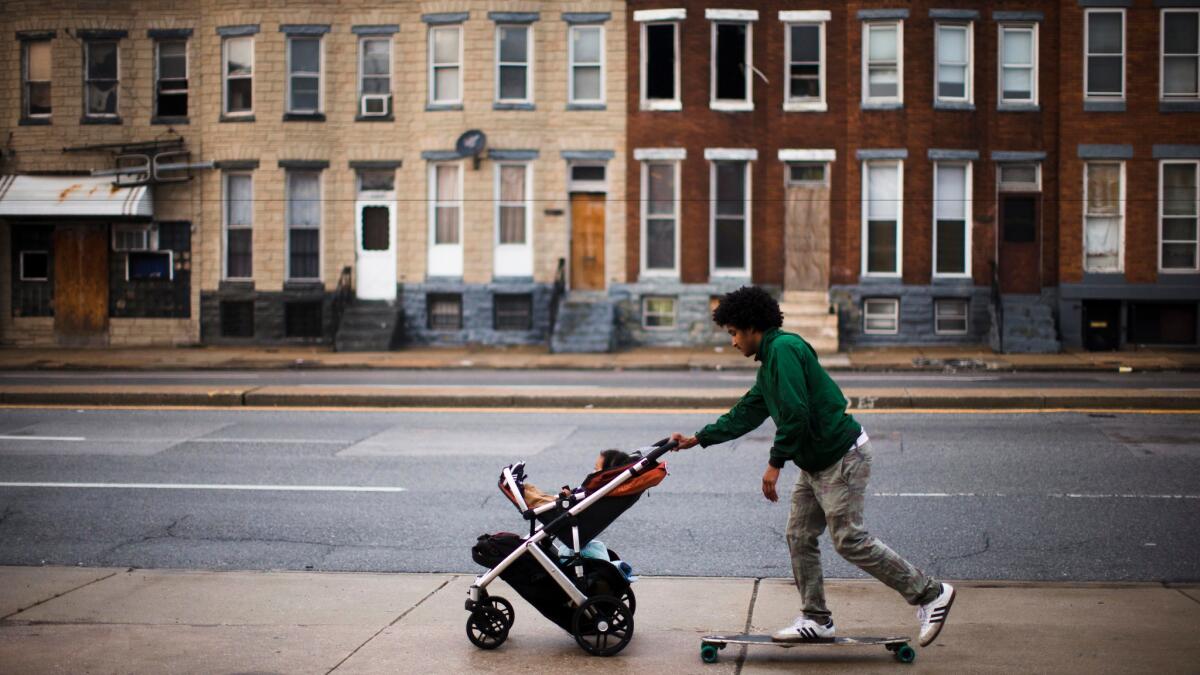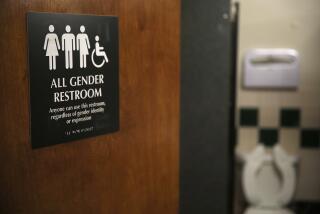Op-Ed: Fretting the un-manning of America

Three things men didn’t do when I was in high school: can tomatoes, knit scarves and push baby strollers. Today the only people I know who do either of the first two are men, and it’s nearly always a man I see pushing the stroller while his mate is working on her smartphone.
These quotidian details illustrate what sociologists describe as the “de-masculinization” of America. Our gender turfs were once distinct — women never grabbed a grease gun, nor men a flour sifter. But they become more intermingled with each passing year.
Back in the 1960s and ’70s, certain turfs were clear. Women — nice women anyway — never went to bars alone. The once-famous Two Keys bar in Lexington, Ky., just off the University of Kentucky grounds was so exclusively a jock bar that even to bring your girlfriend inside drew dark grimaces. Proper ladies took tea in hotel coffee shops.
Parks and playgrounds, numerous sociologists have noted, were the real gender training tracks for baby boomers. Aside from tots and moms, no girls entered the neighborhood playground alone when I was growing up in Eastern Kentucky. The spaces allotted for girls then? Sandboxes and carousels. Climbing cages, basketball hoops and tennis courts were exclusively boy turf. Today, parents gather around the basketball courts and soccer fields to root for girls’ teams. Boys share even the skateboard ramps.
For Southern Californians, nothing may be as shocking as who’s behind the wheel. Women are now the majority of America’s licensed drivers, according to the Auto Club, which keeps numbers on these things. The car insurance industry cites this as a leading factor in the decline in freeway fatalities. Women drivers are less aggressive, more patient in traffic jams, and weave between lanes less often.
Then comes that most fraught public space, the supermarket. There was a time when men never entered a supermarket. My father always sat quietly in the car with his Camels and the newspaper while my mother ventured into the Kroger for chops, cucumbers and cottage cheese. Today, men constitute 51% of the people gripping the grocery cart, though they consistently complain of getting lost.
Finding themselves in an aisle full of cosmetics, or worse, “feminine products,” induces mild panic, men report. This actually caused a dilemma when products like Just For Men and Touch of Gray came along. Correcting hair color was not new, but for men to be seen in public buying the dyes was altogether different. Where to put these products? Certainly not with women’s hair color. Instead, some grocery stores stashed them discretely in the shaving department among the razors and foams and after-shaves.
(The barbershop, of course, was deeply male turf, one of the few places men could be touched by other men, have a razor safely applied to their throats, have their heads gripped by sturdy hands while getting their beards trimmed, their mustaches waxed. Despite a recent uptick in hip urban enclaves, nationally the number of barbershops has been dwindling for decades, replaced by unisex salons mostly run by women.)
Women apparently have no such qualms about entering the men’s department while shopping. Women buy the vast majority of men’s underwear, which until a quarter-century ago meant mostly baggy boxers. Then came Calvin Klein and his bum-clinching tights, marketed first to gay men but then quickly snapped up by wives and girlfriends, launching an entire era of abstruse gender discourse. Do real men wear Calvins? And those willowy lads and hunks modeling on billboard panels around the world: Are these men truly men?
As if giving up some public space weren’t enough, it turns out that we males may also face temporary shrinkages of private space, especially in our brains. Yale neuroscientists have shown that men who personally care for newborn infants — cuddling and caressing them regularly — experience a decrease in the gray matter in the orbitofrontal cortex, the posterior cingulate cortex and the insula. First the barbershop and then the gray matter!
Outraged social conservatives denounce all these changes. They cite the proliferation of stay-at-home dads, now cooking and changing diapers in more than 2 million homes, as a dark sign. They fret that women are now the majority of top-performing college students headed toward jobs in middle and upper management.
Pandering political rhetoric aside, there is a genuine question here: What is masculinity today? Is it flexing steel pecs and biceps? Is it bringing home the bacon? Is it possessing testicles and a functional urinary tube? Or is it merely the possession of a Y-chromosome in an era when the value of muscles plummets before a digital economy?
Today’s chorus of angry men might want to revisit Benjamin Franklin. Drawing on the Latin word vir, or virtue, he characterized manliness as tranquillity, resolution and orderliness — none of which are much present in today’s jeremiads from evangelical pulpits denouncing gender corruption or in the bombast parading as news analysis on Fox and Breitbart channels.
Sandra Thomas, a leading scholar of gender and anger at the University of Tennessee, has spent years tracking how rage has displaced sobriety as the primary marker for masculinity in modern America. Little surprise then as the baby boom morphs into the wrinkle roster, that boomers have found a hero in the misogynistic ranting of Donald Trump and his self-styled brain trust. They are the forgotten people who refuse to push baby strollers or can tomatoes.
Frank Browning is the author of “The Fate of Gender: Nature, Nurture and the Human Future.”
Follow the Opinion section on Twitter @latimesopinion and Facebook
More to Read
A cure for the common opinion
Get thought-provoking perspectives with our weekly newsletter.
You may occasionally receive promotional content from the Los Angeles Times.






